
Squamata is the largest order of reptiles, comprising lizards and snakes. With over 11,500 species, it is also the second-largest order of extant (living) vertebrates, after the perciform fish. Members of the order are distinguished by their skins, which bear horny scales or shields, and must periodically engage in molting. They also possess movable quadrate bones, making possible movement of the upper jaw relative to the neurocranium. This is particularly visible in snakes, which are able to open their mouths very wide to accommodate comparatively large prey. Squamates are the most variably sized living reptiles, ranging from the 16 mm (0.63 in) dwarf gecko to the 6.5 m (21 ft) reticulated python. The now-extinct mosasaurs reached lengths over 14 m (46 ft).
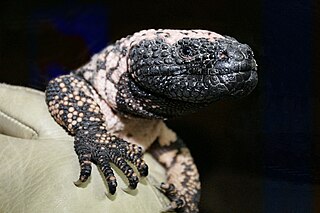
Heloderma is a genus of toxicoferan lizards that contains five species, all of which are venomous. It is the only extant genus of the family Helodermatidae.

Xenosaurus is a genus of lizards; it is the only extant genus in the family Xenosauridae, with 14 species currently recognized. Also known as knob-scaled lizards, they can found in southwestern Tamaulipas and eastern Guerrero in Mexico. These lizards are known to feed on a variety of crawling and flying insects. This genus mostly eats orthopterans, coleopterans (beetles), dipterans, and myriapods.

Megalania is an extinct species of giant monitor lizard, part of the megafaunal assemblage that inhabited Australia during the Pleistocene. It is the largest terrestrial lizard known to have existed, reaching an estimated length of 3.5 to 7 metres, and weighing between 97–1,940 kg (214–4,277 lb), but the fragmentary nature of known remains make estimates highly uncertain.

Toxicofera is a proposed clade of scaled reptiles (squamates) that includes the Serpentes (snakes), Anguimorpha and Iguania. Toxicofera contains about 4,600 species, of extant Squamata. It encompasses all venomous reptile species, as well as numerous related non-venomous species. There is little morphological evidence to support this grouping; however, it has been recovered by all molecular analyses as of 2012.
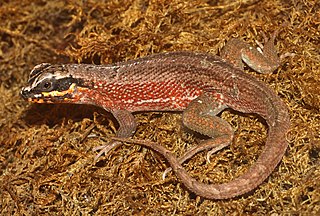
Iguania is an infraorder of squamate reptiles that includes iguanas, chameleons, agamids, and New World lizards like anoles and phrynosomatids. Using morphological features as a guide to evolutionary relationships, the Iguania are believed to form the sister group to the remainder of the Squamata, which comprise nearly 11,000 named species, roughly 2000 of which are iguanians. However, molecular information has placed Iguania well within the Squamata as sister taxa to the Anguimorpha and closely related to snakes. The order has been under debate and revisions after being classified by Charles Lewis Camp in 1923 due to difficulties finding adequate synapomorphic morphological characteristics. Most iguanians are arboreal but there are several terrestrial groups. They usually have primitive fleshy, non-prehensile tongues, although the tongue is highly modified in chameleons. Today they are scattered occurring in Madagascar, the Fiji and Friendly Islands and Western Hemisphere.

The Anguimorpha is a suborder of squamates. The group was named by Fürbringer in 1900 to include all autarchoglossans closer to Varanus and Anguis than Scincus. These lizards, along with iguanians and snakes, constitute the proposed "venom clade" Toxicofera of all venomous reptiles.

Platynota is a polyphyletic group of anguimorph lizards and thus belongs to the order Squamata of the class Reptilia. Since it was named in 1839, it has included several groups, including monitor lizards, snakes, mosasaurs, and helodermatids. Its taxonomic use still varies, as it is sometimes considered equivalent to the group Varanoidea and other times viewed as a distinct group. It is phylogenetically defined as a clade containing Varanidae. It also includes many extinct species.
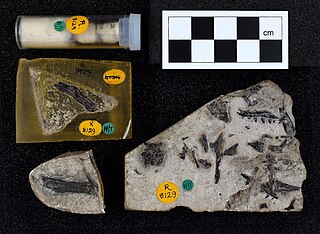
Dorsetisaurus is a genus of extinct lizard, known from the Late Jurassic of North America, and the Late Jurassic-earliest Cretaceous of Europe. The genus was first reported from the Early Cretaceous (Berriasian) Lulworth Formation of the Purbeck Group of Durlston Bay, in Dorset. It has also been reported from the Late Jurassic aged Alcobaça Formation of Portugal, the Aptian-Albian Dzunbain Formation of Mongolia, and the Morrison Formation of Western North America present in stratigraphic zones 2, 4, and 5. It is considered the oldest widely accepted member of Anguimorpha. based on the presence of 11 shared synapomorphies.

Monstersauria is a clade of anguimorph lizards, defined as all taxa more closely related to Heloderma than Varanus. It includes Heloderma, as well as several extinct genera, such as Estesia, Primaderma and Gobiderma, but this group was found to be polyphyletic in the most recent and complete squamate phylogenetic analysis by Reeder et al. (2015).
Headonhillia is an extinct genus of anguine lizard which existed in England during the Eocene epoch. It was first named by Jozef Klembara and Bryony Green in 2010, and represents one of the smallest anguines currently known. The type species is Headonhillia parva. Fossils have been found in the Hampshire Basin.

Shinisauria is a clade or evolutionary grouping of anguimorph lizards that includes the living Chinese crocodile lizard Shinisaurus and several of its closest extinct relatives. Shinisauria was named in 2008 by Jack Lee Conrad as a stem-based taxon to include all anguimorphs more closely related to Shinisaurus than to Anguis fragilis, Heloderma suspectum or Varanus varius. Several recent phylogenetic analyses of lizard evolutionary relationships place Shinisauria in a basal position within the clade Platynota, which also includes monitor lizards, helodermatids, and the extinct mosasaurs. Shinisaurians were once thought to be closely related to the genus Xenosaurus, but they are now considered distant relatives within Anguimorpha. The fossil record of shinisaurians extends back to the Early Cretaceous with Dalinghosaurus, which is from the Aptian aged Yixian Formation of China. Two other extinct shinisaurians are currently known: Bahndwivici from the Eocene of Wyoming and Merkurosaurus from the Late Oligocene of Germany and the Early Miocene of the Czech Republic. An indeterminate shinisaurian is known from an isolated tail found in the Eocene aged Messel pit in Germany.
Myrmecodaptria is an extinct genus of scleroglossan lizard from the Late Cretaceous Djadokhta Formation in Ukhaa Tolgod, Mongolia. The type and only species, Myrmecodaptria microphagosa, was named in 2000 by paleontologists Gao Keqin and Mark Norell. Myrmecodaptria is known from a single holotype skull and lower jaws. It is distinguished from all other lizards by its extremely elongated skull. The eyes are placed close to the snout, which is short and rounded. The top of the skull is covered in bony knobs called osteoderms. The parietal bone at the back of the skull is elongated and about as long as the frontal bones, which are the usually the longest bones along the top of the skull in lizards. The squamosal bone at the back of the skull reaches forward to connect with the jugal bone behind the eye, forming a thin arch between the temporal fenestrae. Myrmecodaptria also has fewer and more widely spaced teeth in its jaws than do most other lizards.
Asprosaurus is an extinct genus of anguimorph lizard from the Late Cretaceous of South Korea. Named in 2015 from the Seonso Conglomerate Formation, the type species Asprosaurus bibongriensis is the first Mesozoic lizard to have been discovered on the Korean peninsula. Because Asprosaurus is known only from fragmentary material, its relationships with other lizards are uncertain. However, features of the lower jaw suggest that it may be a member of a clade called Monstersauria, which includes the living Gila monster.
Carusia is an extinct genus of lizards from the Late Cretaceous of Mongolia. It is a close relative of the family Xenosauridae, which includes living knob-scaled lizards. Fossils of the type and only species Carusia intermedia come from the late-Campanian age Barun Goyot Formation and have been found in the Flaming Cliffs, Ukhaa Tolgod, and Kheerman Tsav fossil localities. Carusia was first described in 1985 under the name Carolina intermedia, but since the name Carolina was preoccupied by a genus of scarab beetles that had been named in 1880, it was renamed Carusia intermedia. Carusia had initially been known from fragmentary skull material, complicating efforts to determine its evolutionary relationships with other lizards; it had variously been described as an indeterminate scincomorph, a xenosaurid, or some other type of autarchoglossan lizard convergent with xenosaurids. However, the discovery of 35 complete skulls in the 1990s, three of which were described in a detailed 1998 monograph, revealed that Carusia was the sister taxon of Xenosauridae, compelling the authors of the monograph to create a new clade called Carusioidea to include both taxa.
Carusioidea is a clade of lizards that includes the family Xenosauridae from Central America and the extinct genus Carusia from the Late Cretaceous of Mongolia. It was named in 1998 after a sister-group relationship was found between Carusia and Xenosauridae. Phylogenetic analysis indicates that Carusioidea is the most basal clade within Anguimorpha. Features that help define Carusioidea include closely spaced orbits or eye sockets separated by fused frontal bones, a connection between the jugal and squamosal bones below the supratemporal arch, and a covering of bony osteoderms over the skull roof. Below is a cladogram showing the phylogenetic relationships of carusioids from Gao and Norell (1998):
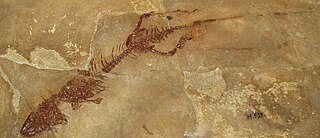
Chometokadmon is an extinct genus of anguimorph lizard from the Early Cretaceous of Italy. The type and only species is Chometokadmon fitzingeri, named by Italian zoologist Oronzio Gabriele Costa in 1864. It is known from only one specimen, a nearly complete skeleton from the comune of Pietraroja in the Apennine Mountains from the sediments of the Pietraroia Plattenkalk. Costa identified the specimen as a lizard, but in 1915 paleontologist Geremia d'Erasmo reclassified the skeleton as that of a rhynchocephalian on the basis of another rhynchocephalian specimen Costa had described, which d'Erasmo thought belonged to the same species. Later studies of the anatomy of these two specimens revealed that they belonged to two different species; Costa's Chometokadmon was a lizard whereas the other specimen, renamed Derasmosaurus in honor of d'Erasmo, was a rhynchocephalian. The first detailed description of Chometokadmon came in 2006, allowing it to be incorporated into a phylogenetic analysis of lizards. The analysis placed Chometokadmon as a member of the clade Anguimorpha, which includes Anguidae, Xenosauridae, and Varanoidea.

Neoanguimorpha is a clade of anguimorphs comprising Monstersauria and Diploglossa. Morphological studies in the past had classified helodermatids with the varanoids in the clade Platynota, while the Chinese crocodile lizard was classified as a xenosaurid. However molecular work found no support in these groupings and instead has found the helodermatids more related to Diploglossa, while the Chinese crocodile lizard and varanoids to form the clade Paleoanguimorpha.
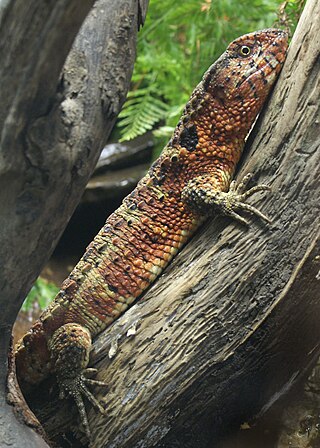
Paleoanguimorpha is a clade of anguimorphs comprising Shinisauria and Goannasauria. Morphological studies in the past also classified helodermatids and pythonomorphs with the varanoids in the clade Platynota, while the Chinese crocodile lizard was classified as a xenosaurid. Current molecular work finds no support in these groupings and instead has found the helodermatids more related to Diploglossa in the sister clade Neoanguimorpha, while the Chinese crocodile lizard is the closet living relative to varanoids. Pythonomorphs represented by snakes today are not closely related to varanoids and are instead a sister lineage to Anguimorpha and Iguania in the clade Toxicofera.

Diploglossa is a clade of neoanguimorphs represented by the families Xenosauridae, Diploglossidae, Anniellidae and Anguidae, the latter three placed in the superfamily Anguioidea. In the past the Chinese crocodile lizard was classified as a xenosaurid; current molecular work has shown evidence the species related to varanoids in the clade Paleoanguimorpha.















